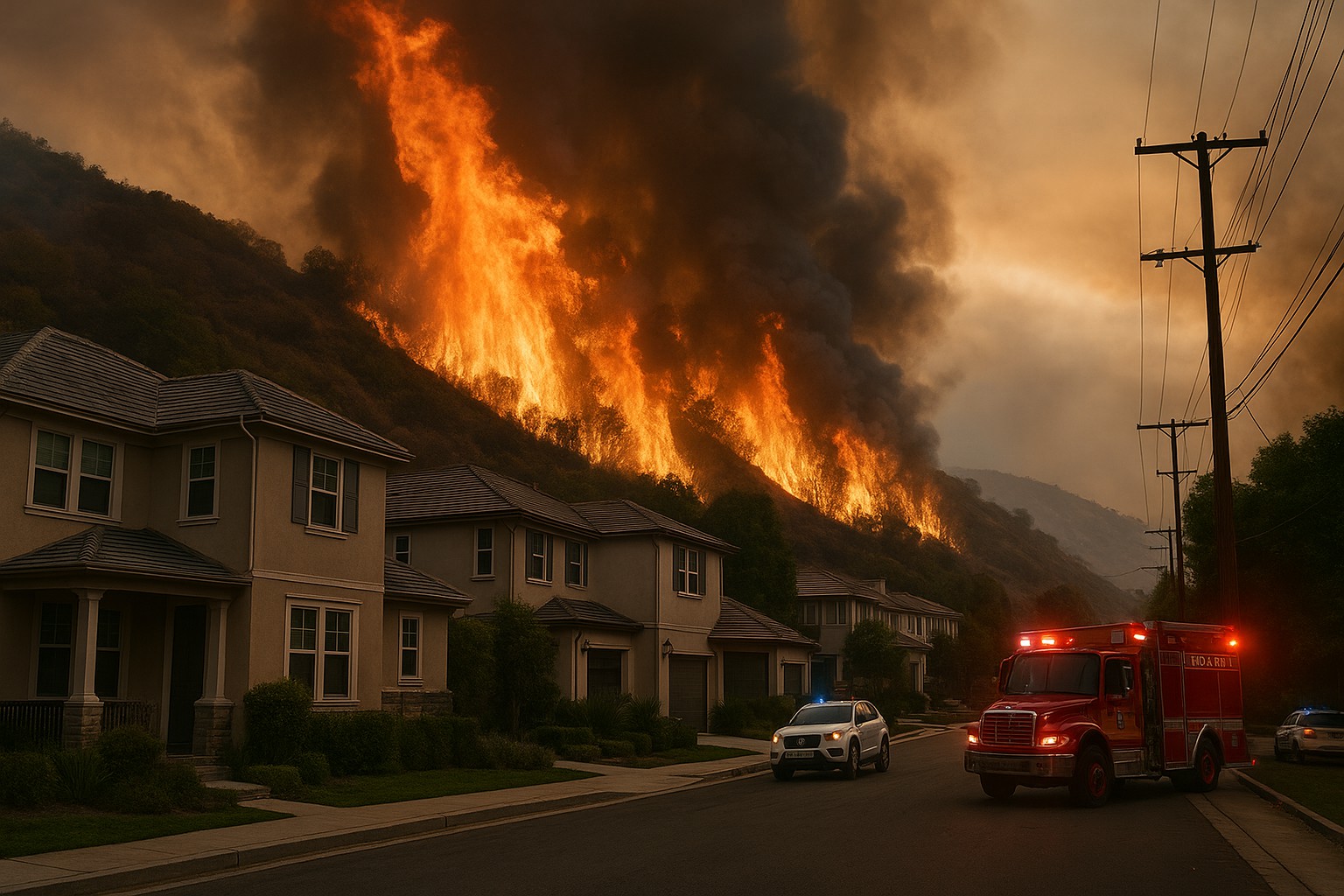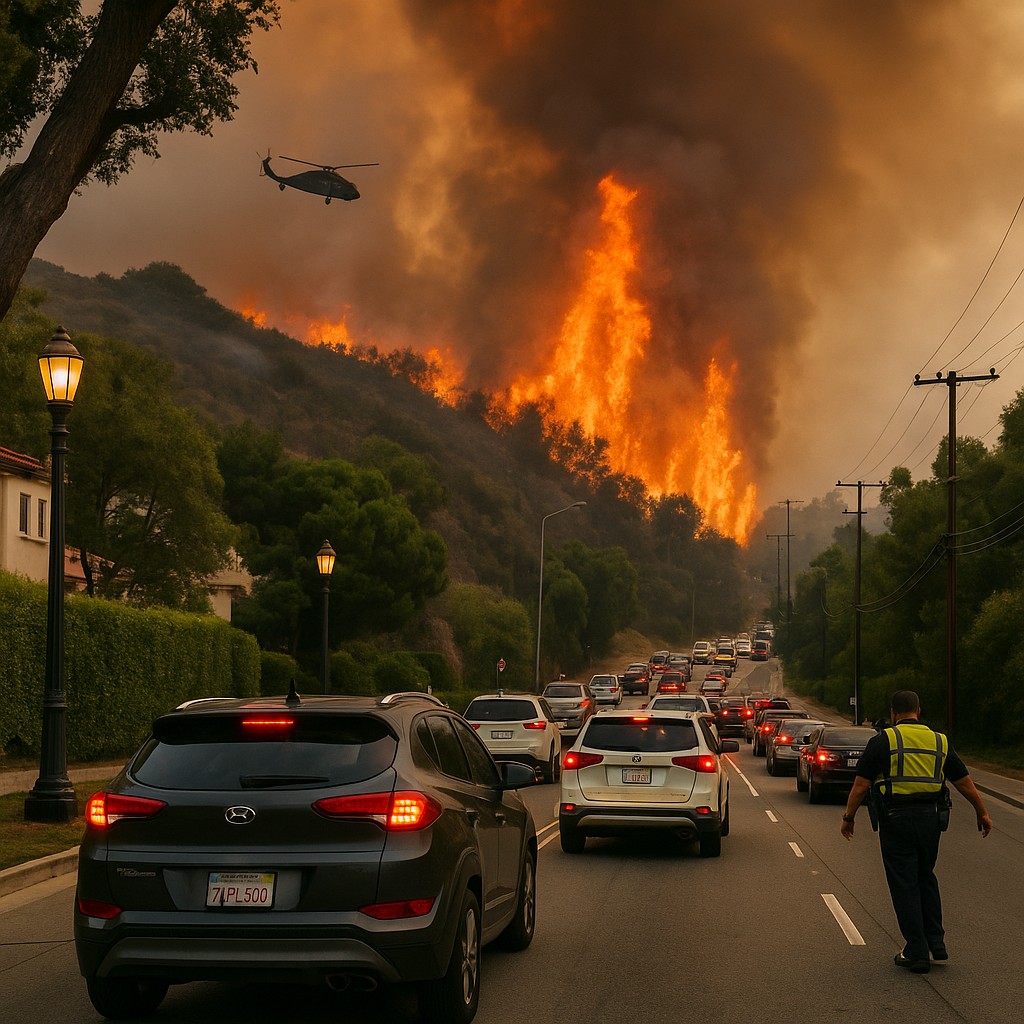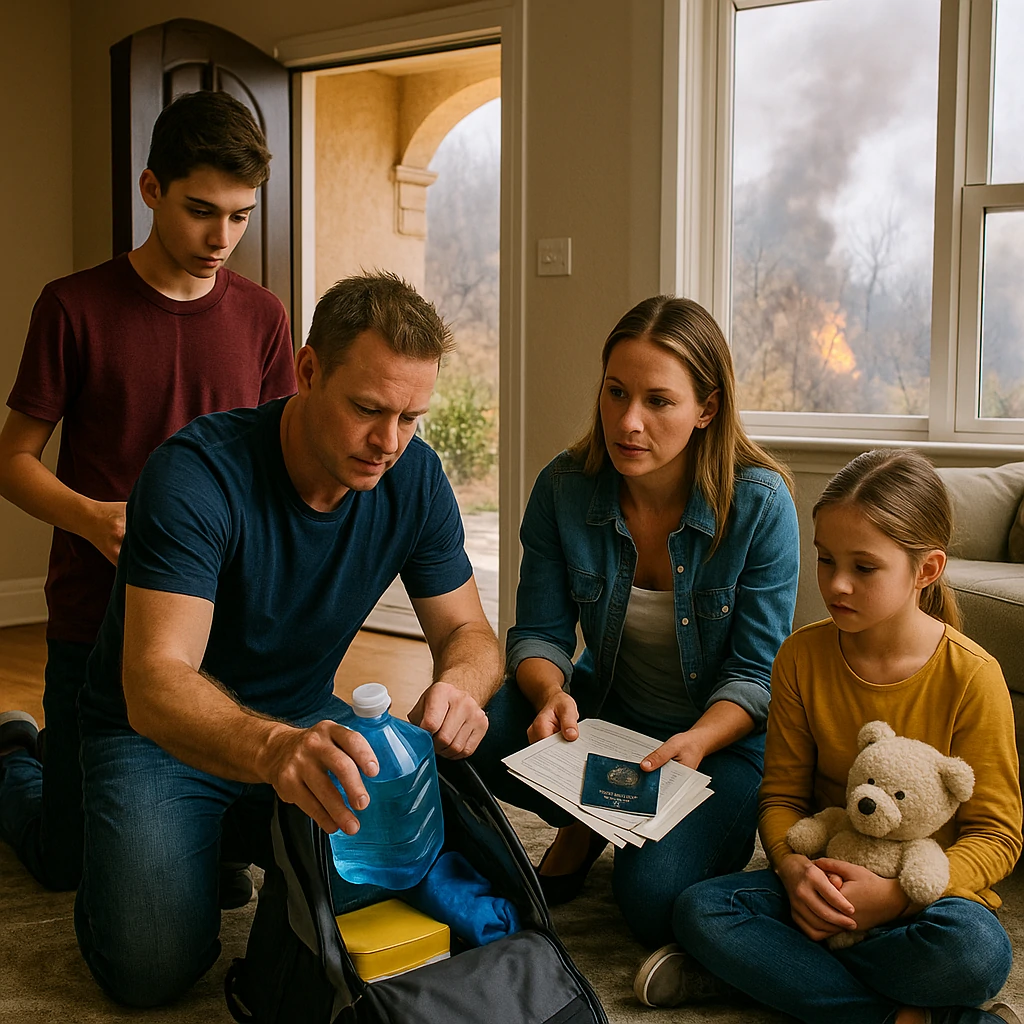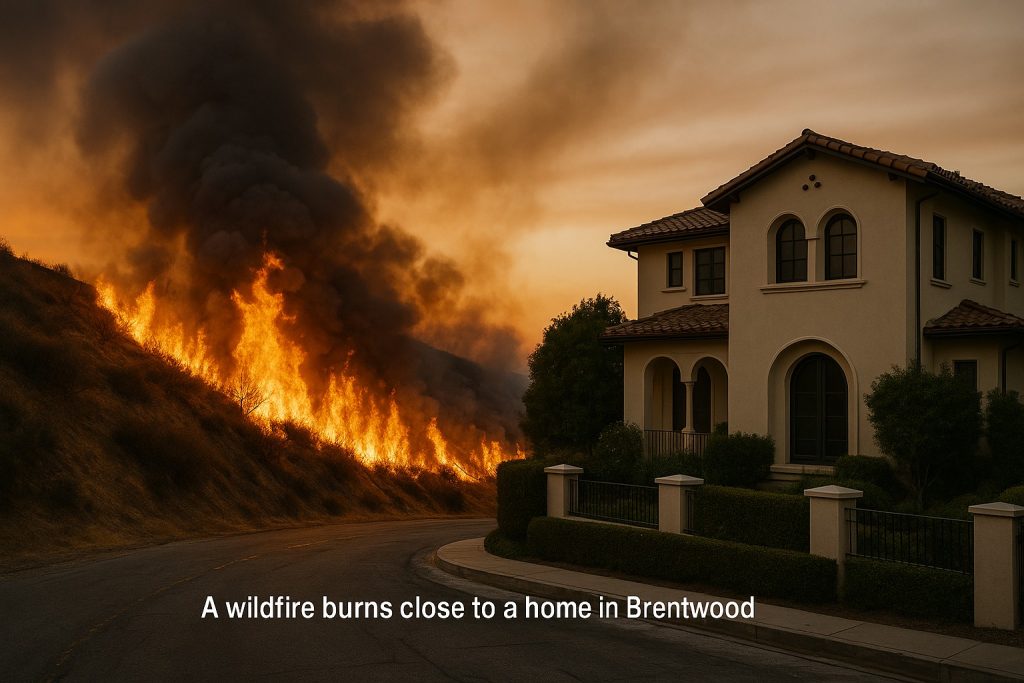Kamala Harris owns a home in Brentwood. This area sits in Los Angeles near the edge of the Santa Monica Mountains. It has luxury homes, hills, and thick brush. In January 2025, wildfires moved fast through this region. Officials ordered residents to leave. Harris’ home was one of them.
Reports say the home is near 435 N Kenter Ave, Los Angeles, CA 90049. The zone faced high wind, dry air, and direct fire risk. Flames reached close. The city issued a mandatory evacuation order.
News spread quickly. People searched terms like “Kamala Harris home evacuated” and “Kamala Harris Los Angeles today.” Others wanted to know if Los Angeles was safe to visit. Questions grew about her property, her neighborhood, and the law behind evacuation alerts.
This guide explains everything. It covers why her home was marked unsafe. It breaks down how evacuation rules work. It also gives you fire safety steps. If you live in a wildfire zone, this article will help you plan, act, and protect your home.
Kamala Harris’ Brentwood Home Faced Real Fire Risk and Evacuation in 2025

Brentwood is a hillside neighborhood in Los Angeles. It sits near the Santa Monica Mountains. The area has dry brush, steep slopes, and narrow roads. This creates a perfect setting for fast-moving wildfires. State maps mark Brentwood as a Very High Fire Hazard Severity Zone. That means homes there face serious danger during fire season.
Many famous people live in Brentwood. Some assume these homes are safer. That is false. Wildfires do not care about wealth or title. Kamala Harris owns a home near 435 N Kenter Ave, Los Angeles, CA 90049. Her property lies in this high-risk zone.
In January 2025, fire crews in Los Angeles spotted a fast-growing blaze. Winds pushed flames toward homes. Officials acted quickly. The Los Angeles Fire Department issued a mandatory evacuation order. Brentwood was on the list.
Kamala Harris’ home was part of the area marked unsafe. Emergency responders moved fast. They closed roads and set up exits. Security teams confirmed that no one was inside the home. Police had legal power to enforce the order if needed.
The evacuation was real, not symbolic. The fire got too close. Authorities treated every home in that zone the same. Kamala Harris’ property faced the same rules and risks as all other houses nearby.
Mandatory Evacuation Orders: What They Mean and Who Must Obey
A mandatory evacuation order means one thing-leave now. It is not advice. It is not optional. It is the law. When fire or emergency officials give this order, everyone must exit.
California law gives police and rescue teams the right to remove people who stay behind. These orders help protect lives. Delaying puts others in danger.
If you stay during a wildfire evacuation, you risk your life. Fires move fast. Smoke fills the air. Roads close. Power lines fall. Homes burn within minutes.
Waiting until you see flames may be too late. You may get trapped. You may lose your way. Rescue teams may not reach you in time.
Leave early. Follow alerts. Grab your bag. Take your family and go. That one step can keep you safe.
Wildfire Evacuation Rules for Renters and Owners
Evacuation rules apply to everyone. It does not matter if you rent or own. If your zone is under an evacuation order, you must leave. The law treats all residents the same.
If you rent, you may wonder who pays for damage. Your landlord covers the building. You are responsible for your personal items. Renter’s insurance may help replace what you lose. You must act fast and file a claim after the fire.
If you are a landlord, you must let tenants know when an order is active. Help them leave safely. Give updates if you get any from local fire officials.
Kamala Harris Evacuated, and So Did Every Neighbor in the Danger Zone

When Brentwood fell under a mandatory evacuation, no one got special treatment. Kamala Harris had to follow the same order as everyone else. Her title did not matter. Every person in the fire zone had to leave.
Families, schools, small businesses, and renters got the same alert. Fire crews did not make exceptions. The rules were clear. The order applied to all homes, including those near Harris’ reported address.
The city used several warning methods. Helicopters circled above. Phone alerts went out. Digital maps updated in real time. Local officials told people to leave without delay.
Most residents packed fast. They followed their plans. Long car lines formed on narrow roads. People drove slowly and stayed calm. Police guided traffic to safe areas.
News stations showed streets filled with vehicles heading downhill. Thanks to early action, no serious injuries happened during the evacuation.
🔥 Real Moment: “I Faced an Evacuation Too”
“Last year, I had just five minutes to grab my pets and leave our home near Topanga Canyon. I didn’t think it could happen to me. We had an emergency go-bag ready, which saved precious time. Seeing the sky glow red behind the hills changed how I think about safety forever.”
👉 Tip: Always prepare a go-bag and track local alerts, even if your area feels safe. Wildfires don’t wait.
Is It Safe to Travel to Los Angeles During Wildfires? Here’s What You Should Know
Travel safety in Los Angeles depends on where you go. The city is large. Some areas stay safe. Others face high fire risk, especially hillside zones like Brentwood, Malibu, and Topanga. These places often fall under evacuation or red flag warnings.
Before you visit, check current alerts. Use the Cal Fire website or the Los Angeles Fire Department site. These give real-time maps and updates. You can see where fires are active and what areas are safe to enter.
Smoke can travel far, even if fire is not close. Poor air quality can affect your health. This matters most for people with asthma or breathing problems. If air alerts are high, avoid outdoor activity.
Use this quick checklist before you go:
- Make sure your hotel is not in a danger zone
- Look at fire and smoke maps the day before your trip
- Follow local news for changes in alerts or closures
- Plan at least one backup travel route
Red flag conditions can change fast. If you follow alerts and prepare, most of the city stays safe. Always check before you travel.
Evacuation Warning vs. Evacuation Order in California: Know the Key Difference
California uses two types of alerts during fire season. One is a warning. The other is an order. You must know the difference to stay safe.
An evacuation warning means danger may come soon. It gives you time to prepare. You should pack your bag, plan your route, and get your car ready. You may stay in your home for now. But you must stay alert. The warning can turn into an order without much notice.
An evacuation order means the threat is real and close. You must leave at once. It is not a choice. The area is no longer safe. If you stay, you risk harm. Fires can trap you or block roads.
When you hear the word “order,” act fast. Do not wait. That decision could save your life.
Legal Rights During Emergency Evacuations in California
In California, fire officials have legal power during an emergency. If you stay in an area under an evacuation order, you can be removed. You may not face arrest, but you cannot block fire teams or delay the response.
Police may stop you from entering the zone again once you leave. This helps protect your safety and the safety of others.
If your home is damaged, you may file a claim with the city or state in rare cases. But in most cases, personal insurance must handle it. Always check your legal rights with a local attorney if you face loss or injury.
For readers interested in how new laws affect vulnerable groups during crises, see New Florida Homelessness Law: Rights, Rules, and Risks for 2025.
What Happens After the Evacuation and How Residents Return Safely

You can only return home after officials say it is safe. Fire crews must check the area first. They inspect power lines, gas leaks, road damage, and hotspots. Only when they finish, the city allows people back.
You may get alerts on your phone or see updates on city websites. Some areas use sirens or radio messages. You may need to show ID at checkpoints to re-enter. Delays can happen if your street is blocked or under repair.
Once inside, some homes may look fine at first. But fire leaves hidden damage. Many people find ash in vents, smoke stains on walls, or weak roof tiles. If you rent or own, contact your insurance company right away.
Most policies cover wildfire damage. Keep photos of the house, receipts, and repair costs. You may qualify for hotel stays, cleanup help, or repairs. Act fast. The sooner you file your claim, the faster you get help.
How Wildfires Impact Home Insurance in High-Risk Areas
Insurance is harder to keep in high-risk fire zones. Some companies may drop coverage. Others may raise your monthly rate. You must know your rights and review your policy every year.
Check for these terms:
- Dwelling coverage (pays to rebuild your home)
- Personal property (covers your items)
- Loss of use (pays hotel bills and meals if you can’t stay home)
Take pictures of your house now. Save receipts for big items. If a fire damages your home, contact your insurer as soon as it is safe.
Rebuilding After Wildfire: What California Homeowners Must Know
Once the fire is out, some homes cannot be saved. If your home is damaged or lost, rebuilding may take months. You will need permits from the city. You may also face new building codes.
Fire-safe roofs, vents, and fences may be required. Contractors must follow new rules. Ask your insurance company to explain what they cover. Get quotes from more than one builder.
It helps to talk with neighbors. Some may rebuild together. That can save time and cost. The process is long, but many homes come back stronger.
Kamala Harris’ California Home and Public Records Linked to Evacuation Zone
Kamala Harris owns a home in Brentwood, Los Angeles. She also owns property in Washington, D.C. In past years, records showed she held real estate in the Bay Area as well.
Her Los Angeles home is linked to 435 N Kenter Ave, Los Angeles, CA 90049. This address lies in a fire-prone hillside area. The property is large, private, and valued in the multi-million dollar range.
In January 2025, wildfire maps showed this location inside the official evacuation boundary. Its location placed it at risk. Local fire officials included this zone in mandatory orders. The evacuation warning applied to all nearby streets, including her block.
Maps from Cal Fire and local agencies confirmed the area was under threat. The home’s location, near dry brush and canyon slopes, made it a concern during the emergency.
What Brentwood Fire Maps Show About Evacuation Zones and Danger Areas
During a wildfire, maps play a key role. They help people see which areas are in danger and where to go. In January 2025, the Brentwood evacuation map showed red and yellow zones near Kamala Harris’ reported address. Fire lines reached close to nearby roads. That zone became a top concern.
The maps showed streets marked for urgent exit. They also listed shelters, roadblocks, and air quality alerts. These tools helped residents plan safe routes and avoid fire paths.
To check real-time maps, visit these official sources:
- Cal Fire (fire.ca.gov)
- Los Angeles Fire Department (lafd.org)
- Ready LA (emergency.lacity.gov)
These sites show active burn areas, evacuation routes, and safety updates. If you live in or near Brentwood, always check these maps during fire season. They could save your life.
How California Sets Fire Hazard Zones and Why Brentwood Ranks High
California uses a system to rank fire risk by location. This is called the Fire Hazard Severity Zone map, created by Cal Fire. It marks areas as low, moderate, high, or very high.
Brentwood ranks as Very High. This is due to its brush-covered hills, dry seasons, and fast winds. Homes near slopes or canyons face the most danger. The map helps cities make rules about home safety and alerts.
You can search your own address using tools from Cal Fire or Ready LA. Knowing your zone helps you plan for future evacuations.
How to Stay Safe in a Wildfire Zone Like Brentwood
If you live in a fire-prone area, you must prepare early. Start by checking your fire risk level. Use your ZIP code on state websites to find your Fire Hazard Severity Zone. Areas marked “very high” need stronger fire safety steps. Brentwood falls into this top category. It has dry brush, steep hills, and fast winds.
To stay safe, every homeowner should take action. Simple steps can protect your home and family.
Here’s what to do:
- Trim trees near your roof and windows
- Clear dry leaves from your yard and gutters
- Replace wood fences with fire-resistant material
- Install ember-proof vents to block sparks
- Keep safety gear, gloves, and masks ready
These changes can lower fire damage and give you more time to escape. In wildfire zones like Brentwood, action saves lives.
What We Learn from Kamala Harris’ Evacuation: Simple Truths for Every Family

Wildfires do not care about power or status. Kamala Harris had to follow the same evacuation order as her neighbors. Her title did not shield her home from danger. The fire zone included her street, just like many others in Brentwood. This shows that every home in a fire path faces the same threat.
If a wildfire can reach the home of the Vice President, it can reach yours too. You must prepare early. Fire spreads fast. You may have little time to think once an alert comes.
Every family needs a clear plan. Keep shoes, clothes, water, medicine, and documents in one place. Know where you will go. Pick two ways out of your area. Share that plan with others in your home.
Action before danger makes the difference. Delay can cost time-and safety. Kamala Harris followed the process. You must do the same. Wildfire safety starts with you.
🔥 Real Insight: “During the Woolsey Fire in 2018, I had just 10 minutes to leave my Brentwood home. The smoke moved faster than expected. My emergency bag saved time. Since then, I always keep a ready-to-go kit near my front door.”
– Local resident near Kenter Canyon
What to Pack in Your Wildfire Go-Bag
Every home in a fire zone needs a ready bag. This is called a go-bag. Pack it now, not later. When fire alerts hit, you may have only minutes to leave.
Go-Bag Checklist:
- Water (at least 1 gallon)
- Flashlight and batteries
- Phone charger and power bank
- Copy of your ID and home documents
- Cash and debit card
- Clothes, socks, and shoes
- Medications and first aid
- Food that lasts (bars, dried snacks)
- Face masks (for smoke)
- Pet food and leash (if needed)
Store this bag near your door or car. Check it often and replace expired items.
Final Thoughts
Kamala Harris’ home in Los Angeles faced a real wildfire threat. The evacuation order was not political. It was based on risk. The fire came close. Officials made the right call. Fire crews moved fast. Residents followed the plan.
This story shows one clear truth-wildfires do not skip anyone. They do not care about title or wealth. They move with wind, heat, and speed. If your home sits in a fire zone, you must treat alerts seriously.
Take action before disaster strikes. Trim trees. Clear dry leaves. Prepare an escape plan. Watch fire maps. Follow every alert. Your home can be rebuilt. Your life cannot.
Stay ready. Stay safe.
To explore a popular device and tech coverage plan that many homeowners use alongside insurance, see our AT&T HomeTech Protection Plan Guide.
Disclaimer: This guide shares public information and safety tips. It does not replace legal advice or official emergency alerts. Always follow orders from local fire or city officials.

